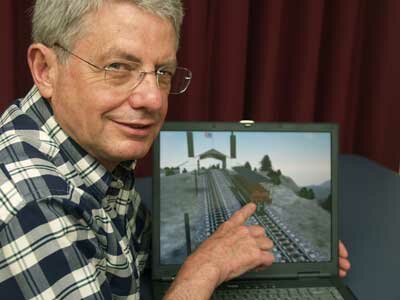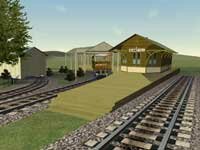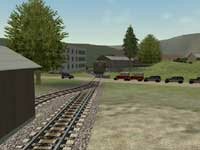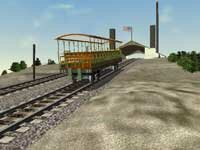|
The Interactive Switchback
|
||||||||||||
|
||||||||||||
|
Second only to Niagara Falls as a nineteenth century America tourist attraction, the Switchback Gravity Railroad may again thrill spectators to its breathtaking eighteen-mile roller coaster excursion through the meadows and forests between Summit Hill and Mauch Chunk. Watching the world pass at speeds exceeding fifty miles per hour while listening to iron wheels on iron track, forest crickets chirping, and soon, wind whistling, if not for the fact this is on a computer screen, you might almost believe you on the Switchback. The Interactive Switchback, a computer graphics model of the first coal and passenger railroad in America, is the product of years of patient work by Walt Niehoff, a Lehighton native who has lived most of his adult life near his former workplace at IBM in Endicott, NY. The inspiration for the simulation came to Niehoff at a 1994 meeting of the Switchback Gravity Railroad Foundation. The organization was brainstorming fundraising ideas, and according to Niehoff, “a light bulb went off in my head. “ He had retired from IBM and was consulting for Doron Precision Systems, a Binghamton, NY developer of driving and entertainment simulation systems.). They manufactured a van-sized theater mounted on a computer controlled hydraulic system. As a roller coaster movie was projected inside the van, the supporting platform would “shake, rattle and roll” giving occupants a physical simulation of an actual ride. Hearing that mechanical engineering students at SUNY Binghamton were looking for a senior project, Niehoff suggested the interactive Switchback. The students developed a feasibility model and presented it to the Foundation. In 2001, when Microsoft released its PC game Train Simulator, Niehoff instantly grasped this as a tool to design the Switchback computer simulation. Now, after a few years spent on track layout, building design, and landscaping, and with the design still having many rough edges Niehoff was ready for the Switchback Foundation to get a sneak peak. The 18-mile loop simulation began at the Summit Hill Depot. Acting as the Switchback operator, Niehoff released the brake and the car emitted metallic grinding sounds as it slowly rolled away from the station. Soon, it was up to speed, passing under the Mount Jefferson Stoney Lonesome bridge and (, and then it approached the Lentz Trail crossing. The simulation included moving vintage cars at the crossings. Niehoff plans to eventually add grazing deer along the tracks. Everything in the simulation is in real time and distance. Every foot of the 18-mile loop is included in the design. As an operator, you normally have only the brakes to control the train during the descent. Too much braking stops the Switchback and too little braking allows speeds in excess of 65 mph, possibly causing a derailment. At the Mount Pisgah and Mount Jefferson Planes, there is an additional controla speed control for ascending the plane that mimics the push provided by the barney car that raised the Switchback car using bands that revolved around an 28-foot diameter drum in the engine house at the top of each mountain. Niehoff first learned about the Switchback when he was required to write a senior theme at Lehighton High School. His father suggested he write about the Switchback and took him to study the reference materials at the Dimmick Library. Although he kept snapshot copies of postcard images of the Switchback, he didn’t meet anyone who knew about the Switchback until attending a Foundation meeting in 1992. Niehoff is the engineering guru of the Switchback Foundation. He, with his wife Pat, built the 28-foot long operating model of the Switchback route on display at the Mauch Chunk Museum and is currently researching the Mount Jefferson barney design with plans to lay a design foundation for a replica barney for the developing Mt. Jefferson barney pit site at the intersection of Lentz Trail and Route 902. |
||||||||||||
|
Return to Home Page
|



